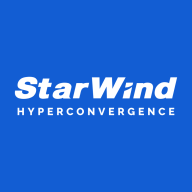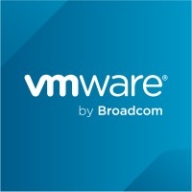

VMware vSAN and StarWind Virtual SAN compete in the virtual storage solutions arena. VMware vSAN has the upper hand due to its seamless integration within the VMware ecosystem.
Features: VMware vSAN features tight integration with VMware products, supporting operations like vMotion and Distributed Resource Scheduler for effective resource management. It provides strong performance by moving storage closer to the CPU, offers policy-based storage management, and seamless scalability. StarWind Virtual SAN offers affordability and ease of use with features like fast deployment on off-the-shelf hardware, efficient data replication, and high availability, making it flexible for various deployments.
Room for Improvement: VMware vSAN could improve its encryption, deduplication, and compatibility with diverse hardware. Users seek better monitoring and integration with different platforms. StarWind Virtual SAN needs enhanced documentation, more intuitive management interfaces, and improved automation capabilities to extend its user-friendliness and reporting features.
Ease of Deployment and Customer Service: VMware vSAN is favored for integrating well within VMware environments, though it requires expert handling. Its technical support is highly rated. StarWind Virtual SAN offers straightforward deployment across various infrastructures and is known for responsive, knowledgeable support, enhancing user experience with a customer-focused approach.
Pricing and ROI: VMware vSAN is considered expensive due to its licensing costs but provides significant operational savings over traditional SANs, justifying its cost with robust features. StarWind Virtual SAN offers a more competitive pricing model, appealing to SMBs with cost-effectiveness and transparent licensing. It delivers similar benefits in functionality leading to a positive return on investment.
We don't sell a lot of redundant servers, so it's not a massive ROI, but the ability to rely on their technical support and the software's ease of setup allows us to reduce labor costs and go to market competitively.
The cost benefits, as far as we consider, are much better with a StarWind VSAN solution, and the training requirements with the ease of administration simplify and reduce our administrator and professional services costs.
Regarding cost savings, for my client, it was about 20K USD for his specific use and as for extending capacity, StarWind made that process easy.
Starting with a smaller infrastructure and scaling as required allows us to save costs initially.
I have seen a return on investment; it's satisfactory in the long run.
Even in the instances where my technical team does not have the ability to manage or troubleshoot or resolve an issue, StarWind's technical team supports and resolves on our behalf very quickly.
They have some awesome guides online that show you exactly how to configure the product, how to do the initial setup, and you can speak with them directly who will be able to connect, verify your setup, run its parameters, and see exactly what's working and what is not, and adjust it, and they really help you with that.
When we set it up, they validate our settings and configurations to ensure we don't miss anything.
I would rate their support nine points.
I am not satisfied with VMware support, particularly with the reaction times, SLAs, and those kinds of issues.
Sometimes the issue is that you don't get the best experience, whether it's the response time or first-level support quality.
I believe that scalability should be further improved, especially considering the possibility that environments may grow exponentially.
I have never needed to scale up or add additional nodes with StarWind Virtual SAN, but we have had to expand, and customer support has been excellent.
StarWind Virtual SAN's scalability is good, and I have had an easy experience adding more space to the system.
It supports up to 64 nodes in a cluster, allowing us to add nodes and expand the cluster as needed.
In my experience, StarWind Virtual SAN is very stable, and I have never had a single instability issue.
It has been working for five years and the customer is still happy with it.
I ran it on a two-node Hyper-V cluster setup, and I didn't experience any unexpected crashes or major issues.
In terms of stability, I give VMware vSAN nine points.
A more intuitive interface or an improved dashboard for monitoring the cluster would also be helpful, as it would facilitate performance tracking and help identify potential issues before they affect services.
There have been cases where not understanding exactly what's failing on the Virtual SAN has been an issue.
Limited feedback in the management GUI is the main area where I would like to see StarWind Virtual SAN get better.
A proper monitoring tool that encompasses both applications and infrastructure would help in quickly resolving issues.
Maybe incorporation of automation to build clusters in a more automated way would be beneficial.
The costs are acceptable and very competitive compared to other hardware-only HCI solutions.
I talked to the sales team, they gave me a quote with a perpetual license with the support and everything went through smoothly.
This is a great product and good support even you are using free version!
This has resulted in a slight cost increase.
Thanks to its seamless integration with Proxmox, the implementation of high availability servers has drastically reduced downtime, which is crucial for our security-focused company.
StarWind Virtual SAN helps us keep customer satisfaction and provides the solutions we need without having to hire many IT specialists.
StarWind's storage virtualization and failover capabilities have made a difference for my clusters through uptime improvements, with zero downtime specific to server host maintenance or even maintenance of the StarWind software itself.
Hot add features are available by default in vSphere, allowing us to immediately increase memory, CPU, and hard drive without any downtime.
The VMware vSAN feature that has had the greatest impact on operational efficiency is the basic software-defined storage functionality.
A one-stack solution from one vendor is the main benefit here.
| Product | Market Share (%) |
|---|---|
| VMware vSAN | 13.0% |
| StarWind Virtual SAN | 2.0% |
| Other | 85.0% |


| Company Size | Count |
|---|---|
| Small Business | 162 |
| Midsize Enterprise | 54 |
| Large Enterprise | 33 |
| Company Size | Count |
|---|---|
| Small Business | 98 |
| Midsize Enterprise | 58 |
| Large Enterprise | 128 |
StarWind Virtual SAN provides high availability and fault tolerance for virtualized environments without the need for dedicated SAN hardware. It allows for real-time replication between servers, shared storage for Hyper-V clusters, and enables vMotion and High Availability features for VMware vSphere. The solution reduces costs and leverages existing hardware while providing a scalable and reliable infrastructure. Valuable features include ease of use, scalability, top-tier support, hardware agnosticism, and the ability to use off-the-shelf standard servers to increase storage space. StarWind VSAN has helped organizations improve performance, data availability, and data security while reducing downtime and providing cost-saving storage options.
VMware vSAN is a software-defined storage product that is used in collaboration with VMware ESXi hypervisor and that provisions and manages storage based on policies, regardless of the underlying hardware. The solution enables you to prime your business for growth through its seamless evolution (it is integrated with vSphere and requires no new tools), its flexibility, and its multi-cloud capabilities. As an industry-leading software, VMware vSAN provides high levels of performance with minimal impact on CPU and memory.
VMware vSAN Features
VMware vSAN has many valuable key features. Some of the most useful ones include:
VMware vSAN Benefits
There are many benefits to implementing VMware vSAN. Some of the biggest advantages the solution offers include:
Reviews from Real Users
Below are some reviews and helpful feedback written by PeerSpot users currently using the VMware vSAN solution.
PeerSpot user Yves S., CEO, Cloud Evangelist at Comdivision Consulting GmbH, says, “vSAN gives us a lot of advantages when we need to expand resources. We have an overall larger host infrastructure, and we split that up for specific customer test and use cases. In that specific scenario, we can easily add more hosts or reduce the number of hosts in the environment.”
A reviewer who works in Infrastructure Security explains, “The ease of use is great. The initial setup and upgrade process was pretty straightforward. And, technical support is great.”
Laurent N., Director at Softlogic, comments, "The feature that I have found most valuable is that it is easy to deploy. It is easy to create and delete virtual servers. It is easy to create the load balancing and the clustering."
We monitor all HCI reviews to prevent fraudulent reviews and keep review quality high. We do not post reviews by company employees or direct competitors. We validate each review for authenticity via cross-reference with LinkedIn, and personal follow-up with the reviewer when necessary.